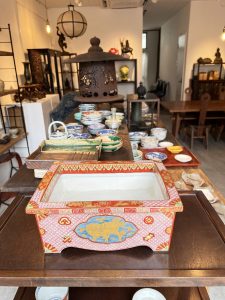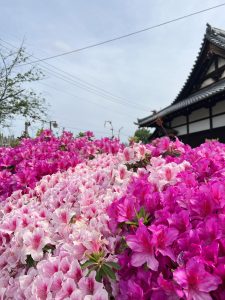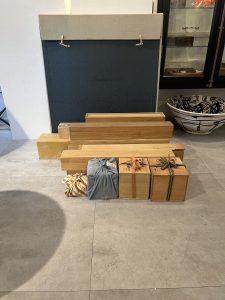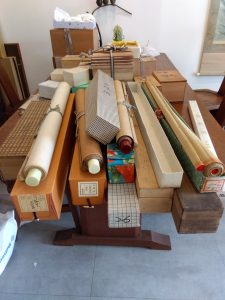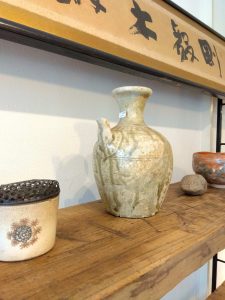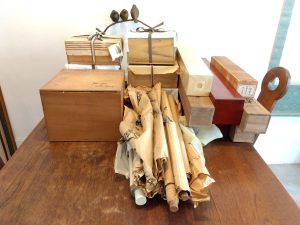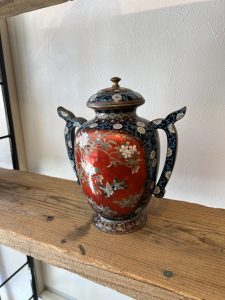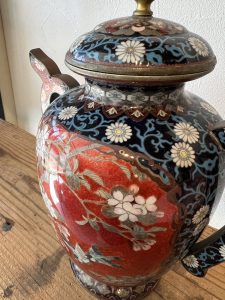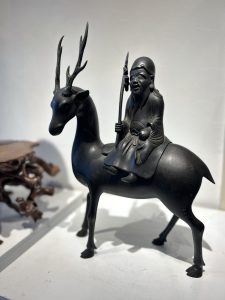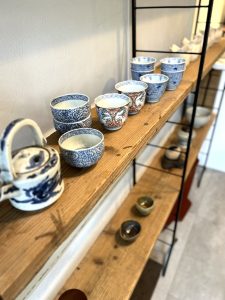うぐいすのさえずりに癒されています(愛知県名古屋市千種区姫池通 骨董品買取 古美術風光舎)
2024.04.30
みなさまこんにちは、スタッフTでございます。
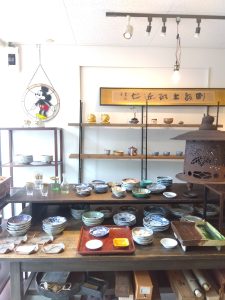
ようやくGWの中盤となりました。この平日は、子育て中の方にはうれしい休息日といったところですね。
気付けば今日で4月も終わり、明日から暦も変わるわけですが、この4月は光のような早さで過ぎた気がいたします。ありがたいことに、お問い合わせも多数いただき慌ただしい日々でしたが、数あるお店の中から当店をお選びいただけたことは、大変うれしく、日々のお仕事の励みとなりました。
さて、最近出勤すると、うぐいすの美しい鳴き声が聞こえてきて、癒されています。
うぐいすの『ホーホケキョ』というさえずりを聞くと、春が来たなと感じます。そんなうぐいす、別名を「春告鳥」といいます。
春になると『ホーホケキョ』と鳴き、私たちに春の訪れを教えてくれるうぐいすですが…実は年中『ホーホケキョ』という鳴き方をするわけではないのをご存知でしたか?言われてみれば、暑くなる頃には『ホーホケキョ』という鳴き声はいつの間にか聞こえてきません。
うぐいすの鳴き声は3種あるといわれ、『ホーホケキョ』と鳴くのは繁殖期のオスだけなのだそうです。
繁殖期を迎えたオスが鳴く『ホーホケキョ』は「さえずり」といい、自分の縄張りにメスを呼ぶために発する鳴き声で、同時にほかのオスに“ここは自分の縄張りだ”と主張する意味合いもあるようです。
一般的にウグイスの繁殖期は2・3月から7月半ばぐらいまでなので、それ以外の時期に『ホーホケキョ』と鳴くことはないのだそう。
では、それ以外の季節はどう鳴いているのかというと、秋から冬にかけては「笹鳴き」と呼ばれる『チャッチャッ』という鳴き方をしていて、これが気温が上昇し、暖かくなってくると『ホーホケキョ』と鳴き、春の訪れを告げるのだそうです。
そしてこうした「ウグイスの初鳴き」は梅や桜の開花日と同様、現在でも気象庁が生物季節観測として全国的に観測を行っており、うぐいすの『ホーホケキョ』という鳴き声は、文字通り“日本の春の訪れを告げる一つの指標”になっているのだそうです。
じつはウグイスは、一夫多妻制の鳥。9割以上の鳥は一夫一妻だそうなので、かなり少数派になりますね。オスのアピールも、メス一羽とカップルになれば終わりというわけではなく、多いと5~6羽ほどの奥さんを持つそうなので、その分長くなるんですね。
そんなうぐいすを実際に見かけたことはありますか?
うぐいすは全身が灰褐色で、どうやら簡単に見つけるは難しそうです。くすんだ黄緑色を『うぐいす色』といいますが、古い時代にメジロと混同されて伝わったようです。うぐいすの大きさはスズメと同じくらいの14~15cmほどで、体形がスズメより細いのでひと回り小さく見えるのだそう。
オスのほうがメスよりもだいぶ大きく、肉眼で「これがうぐいすかも!」と見分けるのは難しそうですが、目の上に白いラインが入っているのが特徴のようですよ。
「声はすれども姿は見えず」の代表のようなうぐいすですが、近くにある城山八幡宮のどこかにいることは間違いないので、声がしたら立ち止まって姿を探してみようと思っています。
ではでは、また。
Hello everyone, this is Staff T.
Finally, we are in the middle of GW. It is a nice rest day for those who are raising children.
I have just realized that today is the end of April, and the calendar will change tomorrow, but I feel as if April has passed as quickly as light. Thankfully, we have received many inquiries and it has been a hectic month, but we are very happy that you have chosen us out of all the stores, and it has encouraged us in our daily work.
Recently, when I come to work, I am soothed by the beautiful singing of the Japanese bush warbler, Uguisu.
When I hear them chirping “Ho ho ho kekyo,” I feel that spring has come. The Japanese nightingale is also known as the “spring-breaking bird.
In spring, they chirp “Ho ho ho kekyo” to tell us that spring has come. If you ask me, you won’t hear them singing “Ho ho ho kekyo” anytime around the time it gets hot.
It is said that there are three kinds of calls of the Japanese nightingale, and only males in the breeding season sing “ho ho ho kekyo.
The “ho ho kekyo” call of the male Japanese bush warbler is called a chirp, and is used to call females to their territory, and at the same time, it is meant to assert to other males that “this is my territory.
Generally speaking, the warbler’s breeding season is from February and March to mid-July, so they do not make the “hohokekyo” call at other times of the year.
When the temperature rises and the weather gets warmer, the song goes “Ho ho ho kekyo,” signaling the arrival of spring.
The first cry of the Japanese bush warbler is still observed nationwide by the Japan Meteorological Agency as part of its seasonal biological observation, just like the blooming dates of the plum and cherry trees. The Japanese bush warbler’s “hohokekyo” call is literally “one indicator of the arrival of spring in Japan.
The Japanese bush warbler is a monogamous bird, and since more than 90% of birds are said to be monogamous, it is in the minority. The male’s appeal does not end when he becomes a couple with one female, but he has as many as five or six wives, so he has to stay that way for a long time.
Have you ever actually seen such a Japanese nightingale?
Uguisus are grayish-brown all over and apparently difficult to spot easily. The dull yellowish-green color is called “igusu-iro,” which seems to have been introduced in ancient times due to confusion with the white-eyes. The size of the Japanese nightingale is about the same as a sparrow (14-15 cm), but its body shape is thinner than that of a sparrow, making it look a bit smaller.
Males are much larger than females, and it is difficult to tell them apart with the naked eye. It is difficult to tell them apart with the naked eye, but they are characterized by the white lines over their eyes.
Although the igusu is a representative of the “heard but not seen” type of bird, I am sure that they are somewhere in the nearby Shiroyama Hachimangu Shrine, so I will stop to look for them when I hear them.
So I will stop and look for them when I hear their voices.
*******************
ご実家の整理やお片付けなどをされている方のご相談などが多くございます。
お片付けなどくれぐれもご無理のないようになさってくださいませ。
風光舎では古美術品や骨董品の他にも絵画や宝石、趣味のお品など様々なジャンルのものを買受しております。
お片付けをされていて、こういうものでもいいのかしらと迷われているものでも、どうぞお気軽にご相談下さいませ。
また風光舎は、出張買取も強化しております。ご近所はもちろん、愛知県内、岐阜県、三重県その他の県へも出張いたします。
まずは、お電話お待ちしております。
愛知県名古屋市千種区姫池通
骨董 買取【古美術 風光舎 名古屋店】
TEL052(734)8444
10:00-18:00 OPEN

